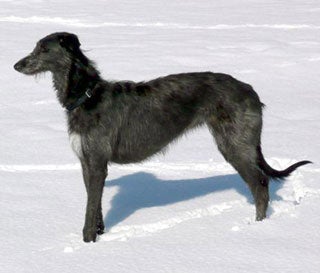Learn about dog breeds
Detailed information & photos on over 190 different breeds
Description
The Scottish Deerhound comes from the line of large dogs. It is often considered both graceful and lean with an almost Greyhound-like physique. According to breed standards, the Scottish Deerhound should have a long and flat skull, sitting atop a thick, tapering neck. This dog is rather handsome in the face, with narrow placed eyes that sits forward almost on the very top of its head. The Scottish Deerhound has forelegs that are stick-like: very narrow and very straight. Its hind legs are muscular.
Coat Description
The Scottish Deerhound’s coat is most ideal if it’s dark or brindled. However, it can also come in darker or lighter shades of plain gray. The raggedness of the dog’s coat is due largely to its thick, wiry overcoat. This overcoat should grow to about 3 to 4 inches long, and it should be close to its skin and should feel harsh to the touch. The head and belly fur should have a satiny or silky texture. There should also be fur on the inside of the dog’s legs, similar to the texture of its tail feathers. The Scottish Deerhound also has fringes of fur on its face and neck, somewhat beard-like looking.
The Scottish Deerhound may come in a variety of dark hues. This dog usually has darker coloration when it is born and the fur will become lighter with age. Dark blue-gray is the preferred breed standard color, but the dog can also come in shades of sandy red and fawn.
History
Although the Scottish Deerhound is said to be one of the oldest breeds of dogs, its origins are rather sketchy. Some say that it comes from the line of the Irish Wolfdog, or the Hounds of the Picts, or even a mix of these two. However, what’s obvious is that the Scottish Deerhound is bred in order to hunt down deer, particularly in the moors of the Scottish Highlands, hence the name.
The highlands can have very harsh climates, with rough patches of terrain; and it is said that these factors may have contributed to its wiry coat, its long legs, and its very large chest cavity. Initially trained to hunt red deer, the dog was later developed to stalk, and actually bring down large bucks and all manner of hoofed game. A silent hunter, the Scottish Deerhound is usually paired with another one of its kind in order for the hunt to be successful. However, similar to the line of Greyhounds, it can run at great speeds but it cannot sustain a chase for a long period of time.
Temperament
The Scottish Deerhound, despite its reputation as a fierce and efficient hunter, is actually a very quiet animal inside the home. The dog is also very friendly with people and seeks the companionship of its human handlers in a polite manner, so to speak. It is not an exuberant dog nor extremely affectionate. It is not known to jump on a person when it is happy; rather, it is content to sit quietly at a person’s side or lay down placidly on its handler’s feet. Unfortunately, this placidness also makes it less desirable as watchdogs. The Scottish Deerhound has been bred into domesticity for so long that it does not see any person, even a stranger, as any sort of threat.
However, this breed of dog likes a quiet environment. A noisy and chaotic home or any home companion - whether human or animal - that happens to be too rambunctious can easily cause it stress. And when the Scottish Deerhound is stressed, it often gives chase and you may have a real situation in your hands.
Health Problems
There are some health concerns regarding the Scottish Deerhound. This is in part due to the breed’s apparent change of lifestyle from the severely active hunting dog to the house pet. Some of the more prominent concerns to look out for include bloating, bone cancer, cardiomyopathy and heart disease.
Grooming
When it comes to grooming, the Scottish Deerhound’s coat needs low maintenance. A once a week brushing will help keep the coat in pristine condition; but the dog does shed quite a bit. Infrequent baths should be given, but only to remove dirt and possible smell.
Exercise
Because the Scottish Deerhound is a hunting dog, it needs plenty of exercise, preferably activities that will require it to run and bound. If you can take it on regular long distance running trips, the dog will most likely benefit from it. This dog should not be allowed to gain weight because it will most likely lead to various complications of heart ailments.
Training
Training and socialization for this breed of dog should always come early because it usually responds very slowly to instructions. The Scottish Deerhound is not particularly keen on impressing its human handlers. It only responds to positive reinforcements and can be very, very stubborn at times. It is also slow to housebreak and even slower to adjust to a new routine, so it would be best if you can extend your patience string by a few inches, or miles.
Advertise | Privacy Policy | Terms of Use | Contact Us © Copyright 2004-2024 PupCity.com. All rights reserved.
